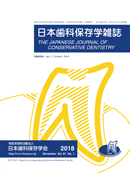Volume 61, Issue 2
Displaying 1-10 of 10 articles from this issue
- |<
- <
- 1
- >
- >|
Symposium in the Journal
-
2018 Volume 61 Issue 2 Pages 79
Published: 2018
Released on J-STAGE: May 07, 2018
Download PDF (135K) -
The Latest Progress of Medical Treatment for Cardiovascular Diseases and Issues in Dental Management2018 Volume 61 Issue 2 Pages 80-84
Published: 2018
Released on J-STAGE: May 07, 2018
Download PDF (1574K) -
2018 Volume 61 Issue 2 Pages 85-89
Published: 2018
Released on J-STAGE: May 07, 2018
Download PDF (851K) -
2018 Volume 61 Issue 2 Pages 90-95
Published: 2018
Released on J-STAGE: May 07, 2018
Download PDF (1165K)
Original Articles
-
2018 Volume 61 Issue 2 Pages 96-103
Published: 2018
Released on J-STAGE: May 07, 2018
Download PDF (2258K) -
2018 Volume 61 Issue 2 Pages 104-112
Published: 2018
Released on J-STAGE: May 07, 2018
Download PDF (372K) -
2018 Volume 61 Issue 2 Pages 113-124
Published: 2018
Released on J-STAGE: May 07, 2018
Download PDF (724K) -
2018 Volume 61 Issue 2 Pages 125-131
Published: 2018
Released on J-STAGE: May 07, 2018
Download PDF (316K) -
2018 Volume 61 Issue 2 Pages 132-144
Published: 2018
Released on J-STAGE: May 07, 2018
Download PDF (350K)
Case Report
-
2018 Volume 61 Issue 2 Pages 145-152
Published: 2018
Released on J-STAGE: May 07, 2018
Download PDF (973K)
- |<
- <
- 1
- >
- >|
